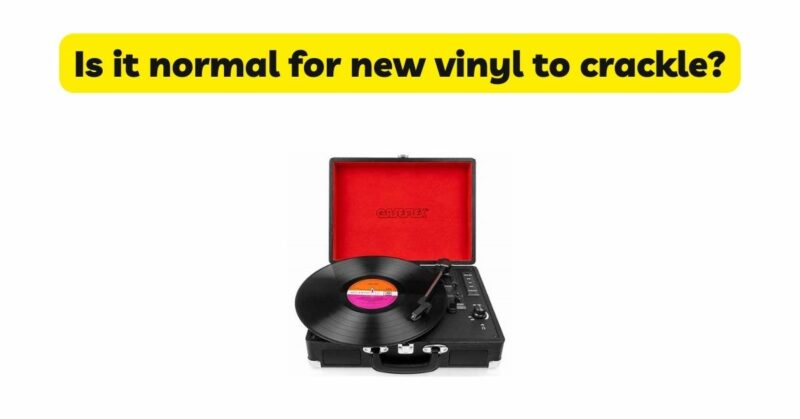Vinyl records have experienced a resurgence in popularity, captivating music enthusiasts with their warm sound and tactile experience. However, along with the vinyl’s enduring charm, there is a persistent perception that crackling sounds are an intrinsic part of the format, especially with new vinyl records. In this article, we will delve into the question of whether it is normal for new vinyl to crackle. By exploring the potential causes of crackling sounds in freshly pressed records, we can shed light on this phenomenon and provide insights for an optimal vinyl listening experience.
- Understanding the Vinyl Soundscape
To determine the normalcy of crackling in new vinyl records, it is essential to understand the intrinsic characteristics of the format. Vinyl possesses a unique soundscape that differentiates it from digital formats. This auditory tapestry is a result of various factors, including the vinyl composition, groove structure, playback equipment, and the analog nature of the medium.
- Vinyl Composition and Manufacturing Processes
The composition of the vinyl compound used in record production can impact its sonic characteristics and the propensity for crackling sounds. While advancements in manufacturing techniques have significantly improved the quality control measures, some factors can still contribute to crackling in new vinyl records:
a. Imperfections in the Pressing Process: During the pressing process, imperfections can occur, such as inconsistencies in the vinyl compound, variations in pressing temperatures, or issues with the stamper. These imperfections can lead to minute surface irregularities that contribute to crackling sounds during playback.
b. Vinyl Compound and Additives: The specific composition of the vinyl compound, including additives and impurities, can influence the presence of crackling sounds. Certain additives used in the vinyl compound can contribute to surface noise, resulting in crackling during playback.
- Dust and Contaminants
Dust and contaminants are common culprits when it comes to crackling sounds on vinyl records, both old and new. Despite manufacturers’ efforts to maintain cleanliness during production and packaging, records can still accumulate microscopic particles:
a. Dust During Manufacturing and Packaging: Despite stringent quality control measures, microscopic particles can find their way onto the record surface during the manufacturing and packaging processes. These particles can contribute to crackling sounds when the stylus passes over them during playback.
b. Dust from Handling and Storage: Brand new vinyl records can accumulate dust and debris during handling and storage, which can lead to crackling sounds during playback. Proper handling and storage practices are crucial to minimize the introduction of dust onto the record surface.
- Static Electricity
Static electricity is a common issue in vinyl playback and can contribute to crackling sounds, particularly in dry environments. When a record accumulates static charge, it can attract dust particles and other debris, resulting in crackling during playback:
a. Static Buildup during Handling: Brand new records can generate static electricity due to friction during handling. This static charge attracts dust and debris, leading to crackling sounds when the record is played.
b. Static from Equipment or Environment: In some cases, the playback equipment or the environmental conditions can contribute to static-related crackling issues. Improper grounding or excessively dry conditions can exacerbate static-related problems.
- Surface Contaminants
Surface contaminants on brand new records can also contribute to crackling sounds. Even if a record appears clean, it may have residual substances that affect playback:
a. Residue from the Manufacturing Process: Some substances used in the manufacturing process, such as release agents or mold-release compounds, can leave a thin film on the record surface. This residue can result in crackling sounds when the stylus moves across the surface.
b. Fingerprints and Oils: Fingerprints, oils, or other residues from handling the record can interfere with playback. These contaminants create additional friction, leading to crackling sounds during playback.
- Stylus Condition and Alignment
The condition and alignment of the stylus, also known as the needle, can significantly impact the presence of crackling sounds in vinyl playback:
a. Stylus Wear and Tear: A worn-out or damaged stylus can struggle to track the grooves accurately, leading to crackling sounds. Regular stylus maintenance and replacement are necessary to ensure optimal playback.
b. Incorrect Alignment: Improper alignment of the stylus and cartridge can also contribute to crackling. A misaligned stylus may not sit correctly in the grooves, causing it to skip or produce unwanted noise.
Conclusion
In conclusion, crackling sounds can occur in new vinyl records, but the degree to which they are present can vary. Various factors, including the vinyl composition, manufacturing processes, dust and contaminants, static electricity, surface contaminants, and stylus condition and alignment, can contribute to crackling sounds during playback. While it is normal for vinyl to exhibit some degree of crackling, excessive or persistent crackling may indicate manufacturing defects or subpar handling. By understanding these factors and employing proper handling, cleaning, and maintenance techniques, enthusiasts can minimize crackling issues and enhance their vinyl listening experience. Embracing the unique auditory characteristics of vinyl and accepting a certain level of crackling can be part of the charm that draws many music enthusiasts to this timeless format.


